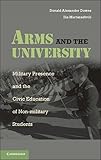Arms and the university : military presence and the civic education of non-military students / Donald Alexander Downs, Ilia Murtazashvili.
By: Downs, Donald Alexander.
Contributor(s): Murtazashvili, Ilia.
Material type: TextPublisher: New York : Cambridge University Press, 2012Description: xiii, 441 p. ; 25 cm.ISBN: 9780521192323 (hardback); 0521192323 (hardback); 9780521156707 (pbk.); 052115670X (pbk.).Subject(s): United States. Army. Reserve Officers' Training Corps | United States. Army -- Recruiting, enlistment, etc | Education, Humanistic -- United States | Soldiers -- Education (Higher) -- United States | Civil-military relations -- United StatesDDC classification: 355.2232071173 Other classification: POL000000
TextPublisher: New York : Cambridge University Press, 2012Description: xiii, 441 p. ; 25 cm.ISBN: 9780521192323 (hardback); 0521192323 (hardback); 9780521156707 (pbk.); 052115670X (pbk.).Subject(s): United States. Army. Reserve Officers' Training Corps | United States. Army -- Recruiting, enlistment, etc | Education, Humanistic -- United States | Soldiers -- Education (Higher) -- United States | Civil-military relations -- United StatesDDC classification: 355.2232071173 Other classification: POL000000 | Item type | Current location | Call number | Status | Date due | Barcode | Item holds |
|---|---|---|---|---|---|---|
 Books
Books
|
Prof. G. K. Chadha Library
South Asian University |
355.2232071173 D7515a (Browse shelf) | Available | BK00009490 |
Includes bibliographical references and index.
Machine generated contents note: Part I. A Normative and Pedagogical Framework: 1. The closing of the university mind: the military/university gap and the problem of civic and liberal education; 2. Education in the regime: how a military presence can enhance civic and liberal education; Part II. ROTC and the University: 3. ROTC and the university: an introduction; 4. ROTC and the Ivies: before the storm; 5. ROTC and the Ivies: the divorce; 6. ROTC, Columbia, and the Ivy League: Sisyphus renews his quest to renew a troubled relationship; 7. Post-DADT: Sisyphus nears the top of the mountain; 8. Pedagogy and military presence: the educational influence of student-soldiers in their own words; 9. Winning hearts and minds?: The consequences of military presence for non-military students; Part III. Military History Examined: 10. Military history: an endangered or protected species?; 11. Half empty or half full?: Military historians' perspectives on the status of military history and the leading departments; 12. Military presence in security studies: political realism (re)considered; 13. Security studies in the wake of the Cold War university: paragons of productive fiction, or throwing the baby out with the bathwater?; Part IV. Concluding Thoughts: 14. Conclusion: placing the military in the university.
"Alienation between the U.S. military and society has grown in recent decades. Such alienation is unhealthy, as it threatens both sufficient civilian control of the military and the long-standing ideal of the citizen soldier. Nowhere is this issue more predominant than at many major universities, which began turning their backs on the military during the chaotic years of the Vietnam War. Arms and the University probes various dimensions of this alienation, as well recent efforts to restore a closer relationship between the military and the university. Through theoretical and empirical analysis, Donald Alexander Downs and Ilia Murtazashvili show how a military presence on campus in the form of ROTC (including a case study of ROTC,♯s̥ return to Columbia and Harvard universities), military history, and national security studies can enhance the civic and liberal education of non-military students, and in the process help to bridge the civil-military gap"-- Provided by publisher.
